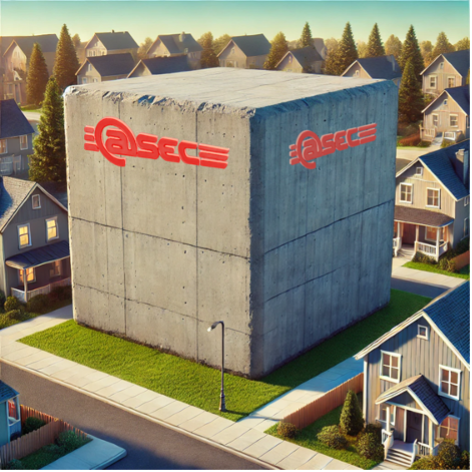April 1, 2025 – The European Network and Information Security Agency (ENISA) has announced a groundbreaking new Protection Profile for certifying 3D house printers, the rapidly growing technology that has been revolutionizing the construction industry. Because, as it turns out, hackers don’t just want your passwords anymore—they want your walls, too.
The Cybersecurity Enforcement for Modernized Extrusion & Networked Technology (CEMENT:2025) Protection Profile is meant to stop cybercriminals in their tracks.
With the demand for affordable housing soaring and traditional construction methods proving too slow, 3D house printing has been hailed as the solution to the problem for future house architecture. Using large robotic arms and specialized cement mixtures, these printers can churn out entire homes in a matter of days—provided nobody reprograms them to spell out “HAXX0R WAS HERE” in the foundation.
The Threat of Cyber-Construction Crimes
As more builders turn to automated home fabrication, security risks have become impossible to ignore. Cybercriminals are no longer content with just hacking websites and ATMs. The digital vulnerabilities of 3D house printers present a whole new set of attack vectors:

- Blueprint Tampering – Hackers could subtly alter the design, leading to homes with no bathrooms, inverted staircases, or walls that spell out embarrassing messages in Braille.
- Backdoors – Like, actual backdoors into your bedroom.
- Denial-of-Cement Attacks – An attacker could flood the printer with useless data, causing it to stop halfway through a job, leaving homeowners with modern art instead of a house.
- Roof-somware – Malicious actors could lock your printer and demand payment before your roof is printed.
- Hacked Concrete – By tampering with the composition of the cement mixture, hackers could cause houses to melt during the hot summer months or turn a disturbing color in cold weather.
ENISA’s New Protection Profile
In response to these escalating threats, ENISA has unveiled the CEMENT:2025 Protection Profile, developed to ensure that 3D-printed houses can counter threats from cyber-criminals during construction.
The key Security Functional Requirement (SFR) measures include:

- Firmware Hardening – Printers will now operate only in “safe mode,” meaning all houses will be printed as featureless concrete cubes, ensuring nobody can tamper with their design.
- Network Isolation – The printers will no longer be Wi-Fi enabled, requiring construction teams to manually enter blueprints using a dial-up modem and a series of punch cards.
- No More Curves – Any attempt to print round objects will be automatically corrected to the nearest rectangle, because circles are just security risks waiting to happen.
- Firewall-Embedded Concrete – Every 3D house printer will include a built-in intrusion detection system that prevents hackers from adding unnecessary features like “stairs” or “rooms.”
- Unhackable Floor Plans – Houses must conform to a standardized government blueprint, featuring 128-bit windows and one pre-approved entrance.
- Tamper Response Protocol – If an attack is detected, the printer will immediately fill the structure with solid concrete—ensuring no unauthorized access… ever.
- Security Level Ultra – If the highest CEMENT:2025 security level is claimed, the house will be printed as a single, solid block of concrete
“Would you rather live in an impenetrable concrete fortress or wake up one morning to find that hackers have reprogrammed your house to be upside-down?” said atsec’s chief security and townhome architect, Stephan Müller.
As always, atsec information security is here to help our customers who seek evaluation of their 3D house printer against the new ENISA Protection Profile. Please come and visit us at our new 3D printed European office:




